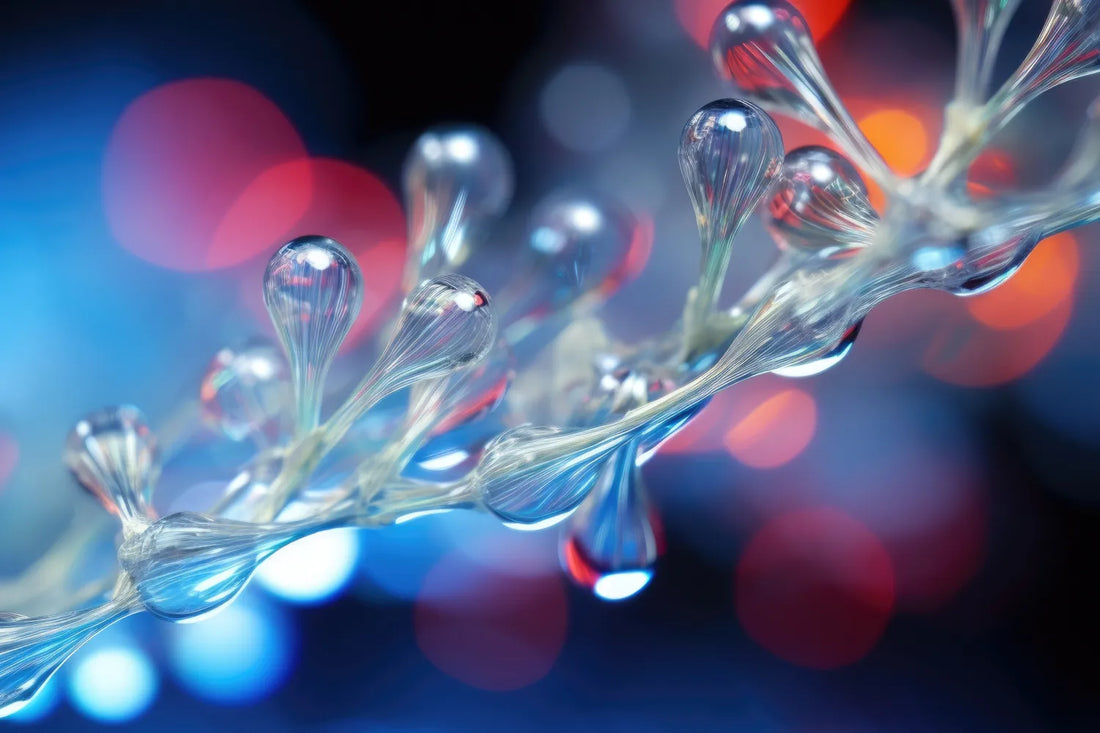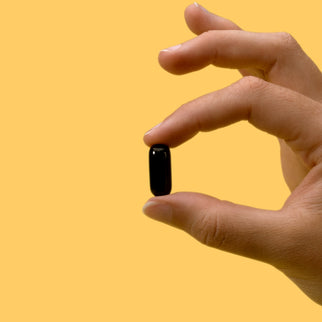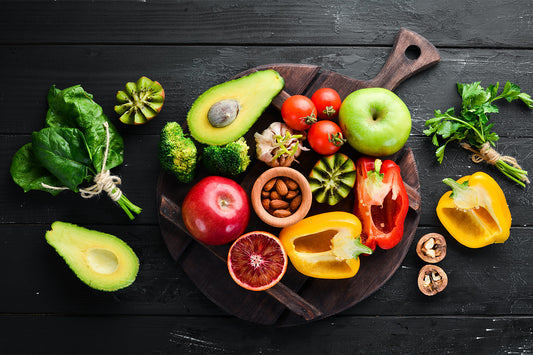In the world of nutrition and health, proteins, vitamins, and nutrients like omega-3 fatty acids are often the stars of the show. However, behind the scenes, there are other lesser-known characters playing crucial roles — and one example is glycolipids.
Here at iwi life, we're passionate about spotlighting these hidden superstars and their contributions to our health and well-being. So, let's dive into glycolipids and learn what they are, where they're found, why they matter to us, and how you can get more of them.
What Are Glycolipids?
Glycolipids are compounds characterized by their unique structure, which combines a lipid molecule (fat) with a carbohydrate molecule (typically a sugar). The prefix "glyco" refers to the sugar component, while "lipid" refers to the fat component. Glycolipids are the most abundant lipid in nature, and are part of the photosynthetic membranes — and, therefore, a signature lipid for plant-based nutrition.
As part of the broader lipid family, glycolipids share the characteristic of being insoluble in water but soluble in organic solvents.
The structure of glycolipids is a compelling study in biological design. The lipid component of the molecule, being hydrophobic, avoids water and prefers to interact with other lipid molecules. On the other hand, the carbohydrate component is hydrophilic, meaning it is attracted to water.
Having this split makes glycolipids perfect for forming the cell membrane, which is the protective outer layer of cells. In this layer, the lipid tails align together, away from the water, while the carbohydrate heads face outward, interacting with the watery environment.
Where Are Glycolipids Found in Nature?
Because glycolipids are the most abundant lipid in nature, they’re found in a variety of natural sources. From the green leaves of plants to the microscopic organisms in the soil, glycolipids are an ever-present part of our natural world. Microorganisms, including bacteria and fungi, produce glycolipids as part of their cell membranes.
One particularly noteworthy source of glycolipids is algae — a treasure trove of beneficial compounds, including glycolipids.
Here at iwi life, we utilize a specific strain of algae, Nannochloropsis, which is known for its high glycolipid content. Our sustainable farming practices allow us to harness the power of these microscopic plants, providing a rich, bioavailable source of highly sustainable glycolipids.
By tapping into the natural wealth of algae, we're able to offer an environmentally friendly and effective way for you to boost your glycolipid intake.What Role Do Glycolipids Play in the Body?
Glycolipids play an integral role in the human body, particularly in the function and structure of our cells.
As we touched on earlier, glycolipids are a fundamental component of the cell membrane, the thin layer that separates the inner workings of a cell from the external environment. This membrane is not just a protective barrier but also a dynamic interface where numerous essential biological processes take place.
Glycolipids contribute to the stability of the cell membrane, ensuring it maintains its fluid yet sturdy nature. This balance is crucial for the membrane to effectively perform its roles, from controlling the passage of substances in and out of the cell to facilitating communication between cells.
Additionally, glycolipids are involved in cell recognition and cell-to-cell interactions, crucial processes that ensure the smooth functioning of our bodily systems. In essence, glycolipids are like the cell's identity card, allowing other cells in the body to recognize it and interact accordingly.
How Do Glycolipids Benefit Our Health?
The benefits of glycolipids extend much further than just the cellular level. While the effects of glycolipids might start on a microscopic level, they can have a profound influence on multiple aspects of your overall health:
Immune System Support
Glycolipids are instrumental in supporting our immune system, playing an active role in the crucial process of cell recognition. They function as biological "name tags," enabling our immune cells to distinguish between the body's own cells, termed "self," and foreign cells or pathogens, termed "non-self."
Each cell in our body has glycolipids embedded in the outer layer of the cell membrane. The carbohydrate component of these glycolipids extends outward, creating a unique pattern that our immune system can recognize. This recognition is a critical first step in mounting an effective immune response.
When a foreign cell or pathogen enters the body, its glycolipids — or lack thereof — signal to our immune system that it is an invader. This triggers a cascade of immune responses, including the activation of white blood cells like macrophages and T-cells, which work to eliminate the threat.
Without glycolipids, our immune system would struggle to distinguish harmful invaders from our own cells, potentially leading to a delayed or inappropriate immune response.
Brain Health
Glycolipids are also found in high concentrations in our brains, where they contribute to various neurological processes.
For starters, they’re essential components of the myelin sheath, a fatty layer that insulates nerve fibers and enhances the speed and efficiency of electrical impulses between neurons. This role alone underscores the importance of glycolipids in maintaining healthy brain function.
Some research suggests that glycolipids may have additional roles in brain health. For instance, certain types of glycolipids, such as gangliosides, are thought to be involved in nerve growth and repair, signal transmission, and memory formation.
How Can We Incorporate Glycolipids into Our Diet?
Incorporating glycolipids into our diet can be a natural extension of a balanced, healthy eating plan. As these compounds are found in a variety of food sources, it's possible to boost your glycolipid intake by making mindful choices about what you eat.
Food Sources
Several food groups are rich in glycolipids and can be easily incorporated into your daily meals:
- Whole grains: Various whole grains like oats and brown rice are excellent sources of glycolipids. Besides, they're packed with fiber, which aids digestion, and are rich in B vitamins, which support energy production.
- Legumes: Several legumes, including lentils, chickpeas, and beans, are not only rich in glycolipids but also provide a good dose of plant-based protein and fiber. They're versatile and can be used in a range of dishes, from salads to soups and stews.
- Vegetables: Certain vegetables, such as spinach and broccoli, contain glycolipids. Including a variety of vegetables in your diet will not only increase your glycolipid intake but also provide a host of other nutrients essential for health.
- Nuts and seeds: Multiple nuts and seeds, particularly flaxseeds, chia seeds, and walnuts, contain glycolipids. They're also high in healthy fats and fiber, making them a nutritious snack option.
Supplements
Incorporating glycolipids into our daily diet can sometimes be a challenge, especially considering our fast-paced lifestyles and potential dietary restrictions or preferences.
This is where supplements, particularly those from iwi life, come into play. They offer a concentrated source of glycolipids, making it easier to ensure you're getting a sufficient amount of these compounds daily.
One of the standout features of iwi life's supplements is their bioavailability, which refers to how readily your body can absorb and utilize the nutrients they provide. Bioavailability is a crucial factor when it comes to supplements, as it doesn't matter how many nutrients a supplement contains if your body can't effectively use them.
iwi life's supplements are designed to be highly bioavailable, meaning that the glycolipids they provide can be readily absorbed into your bloodstream. In fact, glycolipids from iwi life’sNannochloropsis algae have been shown to be more bioavailable than the phospholipids from krill oil, due to the surfactant properties of those glycolipids. While glycolipids tend to be non-ionic surfactants, phospholipids are ionic surfactants.
Are There Any Risks Associated with Glycolipids?
Glycolipids are generally considered safe and beneficial for health. However, as with all nutrients, it's important to maintain a balanced intake.
Consuming an excessive amount of glycolipids, especially through supplements, without a healthcare provider's guidance may lead to imbalances in the body. As always, you should consult with a healthcare provider before making significant changes to your diet or supplement routine.
Remember, while glycolipids offer several health benefits, they're just one piece of the puzzle when it comes to maintaining optimal health. A balanced, varied diet, regular exercise, and adequate sleep are all crucial for overall well-being.
The Takeaway
Glycolipids play a vital role in nutrition and health. They’re a type of lipid that is essential for the proper functioning of cells and have been linked to a range of health benefits, especially involving the immune system and brain. While there are plenty of natural sources of glycolipids, iwi life's plant-based omega-3 supplements offer an easy and effective way to incorporate more of them into your diet.
iwi life's products aren’t just beneficial for your health; they also support a more sustainable and environmentally friendly way of living. By choosing iwi life's algae-based omega-3 supplements, you're not only taking a step towards better health, but also contributing to a more sustainable future.
Now is the perfect time to add iwi life’s supplements to your daily routine. With our unique, sustainable sourcing of glycolipids and their superior health benefits, iwi life's products offer a practical solution for anyone looking to enhance their health while also caring for the planet.
So why wait? Start your journey towards better health and a more sustainable lifestyle with iwi life today.
Sources
Glycolipids | Physics LibreTexts
Molecular Simulations of Glycolipids: Towards Mammalian Cell Membrane Models | PMC
Glycolipids as Immunostimulating Agents | PMC
Monogalactosyldiacylglycerol: The most abundant polar lipid in nature | ScienceDirect
Polar Lipids—Phospholipids and Glycolipids—An Enhanced Omega-3 Structure | Summer Tomato



















